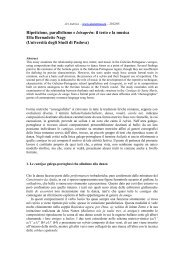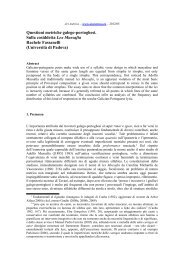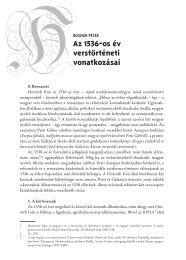The Metrical Structure of Kashmiri Vanɨvun Sadaf ... - Ars Metrica
The Metrical Structure of Kashmiri Vanɨvun Sadaf ... - Ars Metrica
The Metrical Structure of Kashmiri Vanɨvun Sadaf ... - Ars Metrica
You also want an ePaper? Increase the reach of your titles
YUMPU automatically turns print PDFs into web optimized ePapers that Google loves.
Line:<br />
<strong>Ars</strong> metrica – www.arsmetrica.eu – 2012/05<br />
1: ↑CV(VC).CV.CV(V)C ↑ CV(VC).CV.CV(V)C ↑ CV(VC).CV.CV(V)C ↑CV(VC).CV.CV(V)C ↑<br />
2: ↑CV(VC).CV.CV(V)C ↑ CV(VC).CV.CV(V)C ↑ CV(VC).CV.CV(V)C ↑ CV(V)C ↑↑<br />
Note that, for the purposes <strong>of</strong> this study, “CV(VC)” refers to CV, CVC, CV:,<br />
and CV:C syllables, “CV(V)C” refers to CVC, CV:, and CV:C syllable, “CVC”<br />
refers to “VC” and “CVC”, and “CV” refers to CV and V. As noted earlier, there is<br />
no necessary one-to-one correspondence between linguistic entities and metrical<br />
units in Vanivun -- a requirement termed as “text-to-tune matching” or “text-to-tune<br />
alignment” in the literature. To make this point clear, a comparison can be made<br />
with a (true) musical rendition or singing (as opposed to recitation or performance)<br />
<strong>of</strong> (what is underlyingly) a <strong>Vanɨvun</strong> text in the form <strong>of</strong> a bə:t h ‘song’ where text<br />
(linguistic units – words and phrases) and tune (musical constituents) are usually<br />
aligned. 22<br />
4.3. Rhyme Scheme<br />
Two types <strong>of</strong> rhyme are observed in <strong>Vanɨvun</strong> – “internal” rhyme (between the<br />
lines <strong>of</strong> a couplet) and “external” rhyme (across couplets or stanzas). External<br />
rhyme, when present, follows the canonical pattern with rhyming words (or<br />
rhyming components) occurring in the last foot <strong>of</strong> the last line <strong>of</strong> each stanza.<br />
Internal rhyme, however, <strong>of</strong>ten breaks away from the canonical rhyming pattern<br />
resulting in the following two possibilities.<br />
i. Foot #4 in Line 1 rhymes with any foot in Line 2<br />
ii. Foot #4 in Line 2 rhymes with any foot in Line 1<br />
<strong>The</strong>re seem to be no particular restrictions on the presence <strong>of</strong> external rhyme, while<br />
internal rhyme is almost always observed. Consider examples in (10) and (11) for<br />
illustration (Note: Rhyming elements are italicized).<br />
(10) Internal rhyme but no external rhyme<br />
Example 1: Foot #4 in Line 1 rhyming with any foot in Line 2<br />
adɨ-k h or adɨ-l’ok go:mut̪ č h ot̪uye: ‘<strong>The</strong> half-bald handicapped has turned grey<br />
ami k h ot̪ɨ o:suy motuye: ja:n A madman would have been better’<br />
k h aji muri ye:za:r zan hay č h es buhuri: ‘(His) wide-bell trousers look like sacks<br />
vuhuri: t̪ h ə:vinam xulɨhas vat̪ h I hope I can get a divorce within a year’<br />
həndis tay hu:nis ha:ŋkal kərivo: ‘Tie (marry) a sheep with a dog?<br />
gɔdɨni: c h ə:rivo: xulɨhas vat̪ h First, look for an option for divorce’<br />
Example 2: Foot #4 in Line 2 rhyming with any foot in Line 1: 23<br />
č h a:nɨ sɨndi ənim-ay k h ra:vi han məliye:<br />
tət hj pɛʈ h č h əlim-ay k h orɨ p h əliye:<br />
13







